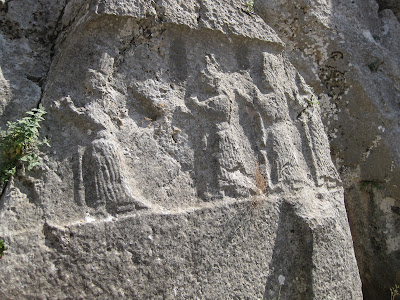 |
| Chamber A Twelve Gods of the Underworld and a Mountain God |
 |
| Chamber A |
 |
| Chamber A (reliefs nos.25-33) |
 |
| Chamber A Relief of Great King Tudhaliya IV |
 |
| Chamber A |
 |
| Chamber A |
 |
| Chamber A |
 |
| Chamber A |
 |
| Chamber A female deities (reliefs nos. 49-50) |
 |
| Chamber A female deities (reliefs nos. 51-54) |
The rock sanctuary of Yazilikaya (= rock with writing) is about 1.5km northeast of the Great Temple at Hattusa. Although it was in use from the 15th century BC it wasn't until the 13th century that the reliefs of (mainly) deities were carved. There are 65 reliefs in Chamber A and 15 in Chamber B. It is hard to see the detail in some of the reliefs because of the level of light and shade. There are optimum times of day for viewing them. It is also hard to identify what some of the reliefs are actually of, in the photos, so I have just labelled these with the relevant chamber - Chamber A.
If you're interested in the reliefs at Yazilikaya a great book to get is Gods Carved in Stone The Hittite Rock Sanctuary of Yazilikaya by Jurgen Seeher. This is a beautifully produced book with 205 pages packed with text, colour and black white photos, drawings and plan diagrams. Two highly recommended Hittite site travel guides are Hattusha-Guide A Day in the Hittite Capital by Jurgen Seeher (this covers both Hattusa and Yazilikaya) and Anatolia: On the Trail of the Hittite Civilization by Ali Kilicaya and Erdal Yazici (this covers a very wide range of sites and museums in Turkey).
 |
| Chamber A female deities (reliefs nos. 49-54) |
 |
| Chamber A |
 |
| Chamber A climactic scene (reliefs nos.41-46) |
 |
| Chamber A |
 |
| Chamber B Twelve Gods of the Underworld |
 |
| Chamber B The 'Sword God', Nergal of the Underworld |
 |
| Chamber B Great King Tudhaliya IV embraced by the god Sharrumma |
 |
| Chamber B Great King Tudhaliya IV embraced by the god Sharrumma |
 |
| View of Hattusa from Yazilikaya |



Impressive pair of posts, Mike. Great photos. Thanks for sharing!
ReplyDeleteThanks Aaron, they're great sites to visit.
ReplyDeleteAmazing carvings which still exist. BTW, do you know were they originally painted?
ReplyDeleteThanks Dean, there are no traces of paint on the reliefs today but it is possible they were painted. Hittite cuneiform texts apparently mention colours and fragments of wall plaster with pigments from Temple 9 in Hattusa are evidence of colourful wall painting. In Egypt at places like Medinet Habu you can still see the original colours on the tunics of the Sea People!
DeleteThis must have been a fascinating site to visit. Thank you you sharing the many photos of the carved reliefs.
ReplyDeleteThanks Jonathan, no worries, visiting these sites brings the history to life.
DeleteAnother interesting and informative post, thanks a lot!
ReplyDeleteBest Iain
Thanks Iain, Turkey is a great place to visit, so much to see!
Delete